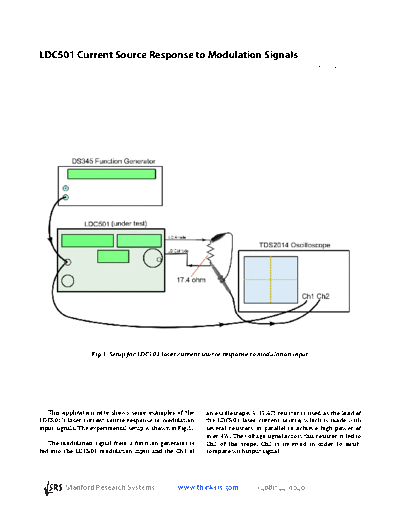Service Manuals, User Guides, Schematic Diagrams or docs for : Stanford Research Systems www.thinksrs.com-LDC Note 8 Modulation Behavior
<< Back | HomeMost service manuals and schematics are PDF files, so You will need Adobre Acrobat Reader to view : Acrobat Download Some of the files are DjVu format. Readers and resources available here : DjVu Resources
For the compressed files, most common are zip and rar. Please, extract files with Your favorite compression software ( WinZip, WinRAR ... ) before viewing. If a document has multiple parts, You should download all, before extracting.
Good luck. Repair on Your own risk. Make sure You know what You are doing.
Image preview - the first page of the document

>> Download www.thinksrs.com-LDC Note 8 Modulation Behavior documenatation <<
Text preview - extract from the document
LDC501 Current Source Response to Modulation Signals
Rev B. Revised Oct 2012
Fig.1 Setup for LDC501 laser current source response to modulation input
This application note shows some examples of the an oscilloscope. A 17.4 resistor is used as the load of
LDC501's laser current source response to modulation the LDC501 laser current source, which is made with
input signals. The experimental setup is shown in Fig.1. several resistors in parallel to achieve high power of
over 4W. The voltage signal across this resistor is fed to
The modulation signal from a function generator is Ch2 of the scope. Ch2 is inverted in order to easily
fed into the LDC501 modulation input and the Ch1 of compare with input signal.
Stanford Research Systems www.thinksrs.com (408)7449040 -1-
1. Sine and Triangle wave response
In Fig.2 the LDC501 output current setpoint is 250mA. The blue trace is the input signal which is 100kHz and
6Vpp. The red trace is the output voltage across 17.4. The vertical axis is 0.87V/div which corresponds to
50mA/div (=0.87/17.4).
Fig.2 LDC501's response to 100kHz Sine wave and triangle wave
2. Square wave and step response
In Fig.3 the blue trace is the input square wave which is 100kHz and 6Vpp. The red trace is the output voltage
across 17.4. The vertical axis is 0.87V/div which corresponds to 50mA/div. The rising edge is about 0.3us
corresponding to 0.35/0.3 = 1.17MHz bandwidth.
Fig.3 LDC501 response to 100kHz square wave and step response
Stanford Research Systems www.thinksrs.com (408)7449040 -2-
3. Limited output
In Fig.4 the output current setpoint is 250mA and current limit setting is 300mA. The blue trace is the
modulation input signal whose amplitude is 6Vpp with 10kHz, 50kHz, 100kHz or 500kHz frequencies. The red
traces are the output voltages across the 17.4 resistor load.
The overshoot is dependent on the cable parasitic parameters and the slew rate of the input signal.
Fig.4 LDC501 limits the output current to 300mA.
Stanford Research Systems www.thinksrs.com (408)7449040 -3-
4. Recovery from 0mA
In Fig.5 the output current will not go below 0mA. When modulation pushes output to go to 0mA, a short
recovery time is required to allow the internal current source to get out of saturation.
Fig.5 LDC501 recovers from 0mA output.
5. Bandwidth change
A smooth transition will occur during bandwidth changes. In Fig.6, a bandwidth change will not cause output
current glitches.
Fig.6 LDC501 bandwidth change from 1.2MHz to 10kHz and back.
Stanford Research Systems www.thinksrs.com (408)7449040 -4-
6. Mode change
CC to CP, or CP to CC mode changes can be done while the laser is on. A smooth transition will occur without
glitches in the output current. In Fig.7 the input modulation signal is 5kHz. In CC mode, the LDC501 has a
bandwidth of 1.2MHz whereas CP mode has lower bandwidth of 5kHz and also has a different transfer functions.
Fig.7 CC to CP, and CP to CC mode changes.
7. Soft start and turnoff of the current source
When LDC501 is turned ON, the output current will softly rise to its setting point (250mA in Fig.8 and is
modulated). When it's turned OFF, the output current will shut off immediately.
Fig.8 LDC501 soft start with modulation input and the fast turnoff.
Stanford Research Systems www.thinksrs.com (408)7449040 -5-
◦ Jabse Service Manual Search 2024 ◦ Jabse Pravopis ◦ onTap.bg ◦ Other service manual resources online : Fixya ◦ eServiceinfo